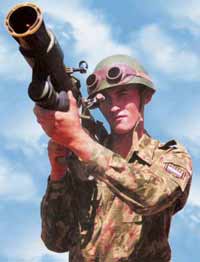USA lures poverty-stricken Nicaragua with medical equipment in return to Russian missile systems
The US administration offered Nicaragua to exchange 657 Russian man-portable, shoulder-fired surface-to-air missile systems to medical equipment for the nation’s healthcare system, RIA Novosti reports with reference to Nicaraguan TV channel Canal 8. The amount of the transaction has not been exposed yet.

“The US government put forward a suggestion to the Nicaraguan administration to deliver medical equipment in exchange to 657 Strela-2 Russian-made missile systems. I hope that we will sign an adequate agreement in the nearest future,” the US Ambassador to Nicaragua, Paul Trivelli said in a statement.
The Nicaraguan Army currently uses 1,000 Strela-2 systems, which the country purchased from the USSR during the 1980s. About 400 of those systems will be left at Nicaraguan army storage facilities in the event the nation decides to sign the deal with the USA.
It is worthy of note that the USA has repurchased over 22,000 man-portable, shoulder-fired missile complexes in different countries of the world over the recent several years. The Pentagon says that the USA conducts such policy not to let various terrorist groups take possession of the complexes.
The 9K32 "Strela-2" (NATO reporting name SA-7 Grail) is a man-portable, shoulder-fired, low-altitude surface-to-air missile system with a high explosive warhead and passive infrared homing guidance. It is broadly comparable to the US Army FIM-43 Redeye. It was the first generation of Soviet man portable SAMs, entering service in 1968, with series production starting in 1970.
The 9K32M "Strela-2M" (NATO reporting name SA-7b "Grail" Mod 1) was introduced in 1971 and featured a number of improvements, increasing both its range and the size of its warhead.
The SA-7 is a tail-chase missile system and its effectiveness depends on its ability to lock onto the heat source of low-flying fixed and rotary-wing aircraft. The missile's simple infra-red seeker mechanism is easily overwhelmed by simple countermeasures like flares, and pulsing "hot brick" jammers, and even environmental effects like infra-red reflections from clouds.
The Strela-2 has a small directed-energy blast fragmentation warhead with impact and grazing fuzes. The impact fuze detonates the warhead immediately upon impact, while the grazing fuze reacts to the slightest bending of the missile fuselage. The warhead weighs 1,1kg, including 370g HE content in a pre-fragmented casing.
The small warhead had the drawback of low kill probability against jet, and especially multi-engine targets; as the missile homed in on the hottest spot, it typically hit only the afterburner nozzles, and due to the small size and instantaneous fuzing was not unusual that it failed to destroy even the engine that was hit. Although the basic warhead design remained the same in all Soviet MANPADS from Strela-2/2M through Strela-3 and Igla-1 to the final Igla, the later missiles had much-improved lethality with little extra warhead weight due to better terminal homing aimed at hitting the aircraft fuselage, delayed fusing allowing the missile to penetrate into the target before detonation, and in later variants also a 20g secondary charge to set off remaining rocket fuel.
Despite its shortcomings in range and lethality the Strela-2 did force enemy pilots to fly higher, into the engagement envelope of more capable air defence systems. In addition, in several cases it has forced enemy pilots to adopt higher altitude bombing tactics, which degraded the accuracy and usefulness of air strikes.
The maximum range and altitude of these missiles were consistently underestimated in the West. For example, although an altitude limit of 1,500' was widely quoted, an SA-7 hit an Omani jet (in 1974) at 11,500 feet.
Agencies
Subscribe to Pravda.Ru Telegram channel, Facebook, RSS!





